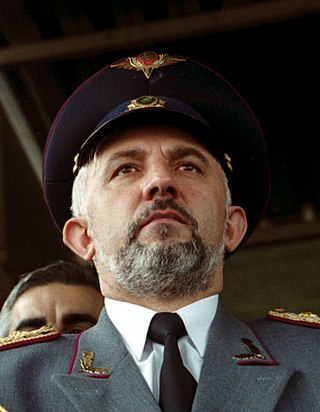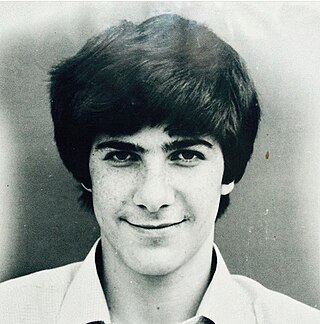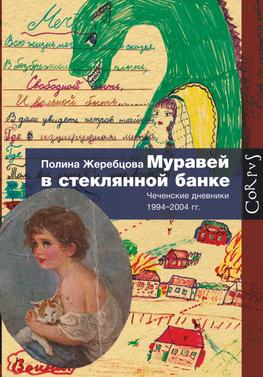Related Research Articles

The First Chechen War, also known as the First Chechen Campaign, or the First Russian-Chechen war, was a war of independence which the Chechen Republic of Ichkeria waged against the Russian Federation from December 1994 to August 1996. The first war was preceded by the Russian Intervention in Ichkeria, in which Russia tried covertly to overthrow the Ichkerian government. After the initial campaign of 1994–1995, culminating in the devastating Battle of Grozny, Russian federal forces attempted to seize control of the mountainous area of Chechnya, but they faced heavy resistance from Chechen guerrillas and raids on the flatlands. Despite Russia's overwhelming advantages in firepower, manpower, weaponry, artillery, combat vehicles, airstrikes and air support, the resulting widespread demoralization of federal forces and the almost universal opposition to the conflict by the Russian public led Boris Yeltsin's government to declare a ceasefire with the Chechens in 1996, and finally, it signed a peace treaty in 1997.

The Second Chechen War took place in Chechnya and the border regions of the North Caucasus between the Russian Federation and the Chechen Republic of Ichkeria, from August 1999 to April 2009.

Aslan (Khalid) Aliyevich Maskhadov was a Soviet and Chechen politician and military commander who served as the third president of the unrecognized Chechen Republic of Ichkeria.

On 19 August 2002, a group of Chechen Freedom fighters armed with a man-portable air-defense system brought down a Russian Mil Mi-26 helicopter in a minefield, which resulted in the death of 127 Russian soldiers in the greatest loss of life in the history of helicopter aviation. It was also the most deadly aviation disaster ever suffered by the Russian Armed Forces, as well as its worst loss of life in a single day since the 1999 start of the Second Chechen War.

The First Battle of Grozny was the Russian Army's invasion and subsequent conquest of the Chechen capital, Grozny, during the early months of the First Chechen War. The attack lasted from December 1994 to March 1995, which resulted in the military occupation of the city by the Russian Army and rallied most of the Chechen nation around the government of Dzhokhar Dudayev.

The 1999–2000 battle of Grozny was the siege and assault of the Chechen capital Grozny by Russian forces, lasting from late 1999 to early 2000. This siege and assault of the Chechen capital resulted in the widespread devastation of Grozny. In 2003, the United Nations designated Grozny as the most destroyed city on Earth due to the extensive damage it suffered. The battle had a devastating impact on the civilian population. It is estimated that between 5,000 and 8,000 civilians lost their lives during the siege, making it the bloodiest episode of the Second Chechen War.
Human rights violations were committed by the warring sides during the second war in Chechnya. Both Russian officials and Chechen rebels have been regularly and repeatedly accused of committing war crimes including kidnapping, torture, murder, hostage taking, looting, rape, decapitation, and assorted other breaches of the law of war. International and humanitarian organizations, including the Council of Europe and Amnesty International, have criticized both sides of the conflict for blatant and sustained violations of international humanitarian law.

Ramzan Mezhidov (1967–1999), was a freelance Chechen cameraman. On October 29, 1999, together with Shamil Gigayev, a cameraman for independent Nokh Cho television station in Grozny, he was killed during a Russian air strike on refugees fleeing Chechnya.

The Grozny ballistic missile attack was a wave of Russian ballistic missile strikes on the Chechen capital Grozny on October 21, 1999, early in the Second Chechen War. The attack killed at least 118 people according to initial reports, mostly civilians, or at least 137 immediate dead according to the HALO Trust count. Hundreds of people were also injured, many of whom later died.
Iskandar Khatloni was a journalist from Tajikistan who worked for Radio Free Europe and was murdered in Moscow, Russia while covering the Second Chechen War.

Polina Zherebtsova's Journal: Chechnya 1999-2002 is the edited diary kept by Polina Zherebtsova while she was living in Grozny, the capital of the Chechen Republic. It was published in September 2011 in Russia. Zherebtsova wrote the diary when she was 14–17 years old, from the beginning of The Second Chechen War until December 2002. It tells the story of ethnic relations between Russian and Chechen peoples and of the lives of civilians during the war. This book is non-fiction, but real names were changed by the author in the book.
Musa Muradov is an ethnic Chechen Russian journalist. In 2003, he was awarded the International Press Freedom Award of the Committee to Protect Journalists for his reporting on the Second Chechen War.
Groznensky Rabochy was a Russian weekly newspaper based in Grozny, Chechnya from 1917 to 1992, and from 1994 to 2001.

Ant in a Glass Jar: Chechen Diaries 1994–2004 (Russian: "Муравей в стеклянной банке. Чеченские дневники 1994–2004" is a 2014 documentary book that is an author's diary about the years spent in Chechnya from 1994 until 2004. It was written by Polina Zherebtsova, while she was 9–19 years old.
References
- ↑ IPI DEATH WATCH
- 1 2 Ann K. Cooper (5 November 1999). "Correspondent killed in Grozny rocket attack". Committee to Protect Journalists. Retrieved 31 January 2012.
- ↑ IPI Death Watch
- ↑ RUSSIA (CHECHNYA): CAMERAMAN KILLED